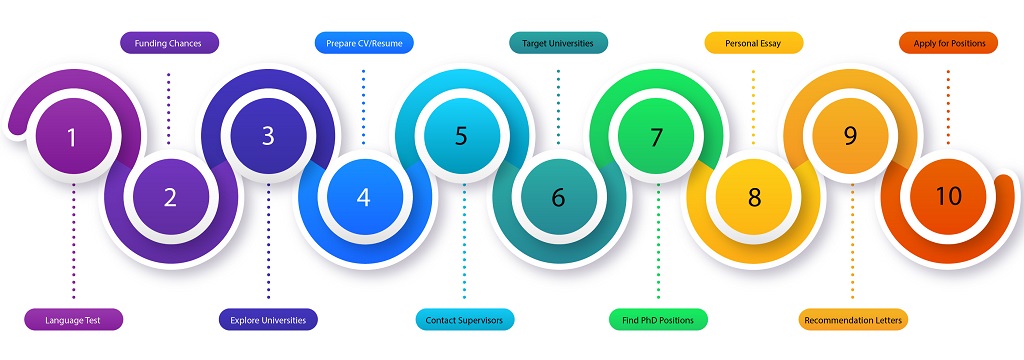
Nowadays, the number of applicants looking for PhD positions is increasing dramatically. Among them, fully funded PhD positions are the most favorable. Some of the frequently searched phrases on search engines are “fully funded PhD in Australia“, “fully funded PhD in UK for British students”, and “fully funded PhD in USA for international students”. Compared to the master’s applicants, PhD applicants have a higher chance of winning financial support. Supervisors, universities, and industrial sectors dedicate most funding sources (ca. 90%) to PhD vacancies. Herein, we share a general roadmap for the application process from the first steps to securing a fully funded PhD position. We will also explain how Applyindex’s tools are designed to streamline the process for you.
What is a Fully Funded PhD?
A PhD, officially known as a Doctor of Philosophy, represents the pinnacle of academic achievement in the world. This prestigious qualification usually centers around a rigorous research-based endeavor, where candidates delve into the realms of original and substantial contributions to their chosen field. A cornerstone of this journey is writing a dissertation, often spanning up to 100-300 pages, which must undergo a rigorous defense during an oral examination before a panel of esteemed experts in the chosen field. The journey towards a degree typically unfolds over a specific time frame (three to six years full-time), depending on the host country where you do your PhD. When a financial source funds the entire journey, it is a “fully funded PhD”.
Traditional Pathway to Get a Fully Funded PhD
The PhD application process can often be unfamiliar, chaotic, overwhelming and confusing, so most students do not know where to begin. Namely, the process is divided into 10+ steps with each step covering a major part of the application process. Of course, these steps will differ slightly for every case, depending on various parameters such as degree level and the countries students apply to. This traditional method is inefficient, time-consuming, and filled with uncertainty. These steps are often spread across different platforms, making the process complex and overwhelming, like a “chaos” or “disaster”! For instance, most PhD applicants typically go through the following steps:

How Applyindex Helps to Get Fully Funded PhD Positions
We provide an all-in-one, intelligent platform that enables applicants to navigate and manage their application process to secure fully funded PhD positions at universities. It efficiently and reliably evaluates the strength of your CV, estimates your chances of securing full funding, matches you with professors who have research grants, organizes your notes, and handles many other tasks throughout your application process. If you’d like to use Applyindex’s tools, please create and complete your profile if you haven’t done so yet. After logging into your account, you should complete your profile to benefit from Applyindex’s features.
Step 1. Prepare for Language Proficiency Tests
Depending on the country and the field you intend to apply, you might need to take English, French, German, etc. language proficiency tests. However, most universities require English test scores from PhD applicants. Unless you are excepted from taking and English text (when you are a citizen of native English-speaking countries or you have recently completed a university degree in English), international students must take an English proficiency test (e.g., IELTS Academic, TOEFL iBT, PTE Academic, and Duolingo). American and Canadian universities may ask for additional English qualifications such as GRE or GMAT, and it will depend on the student’s field of study. This step can be extended till you submit your application officially.
Step 2. Evaluate CV Strength and Funding Chance
The second step for any student applying to universities is understanding where their CV strength can take them, especially when seeking full financial support like fully funded scholarships. PhD applicants, in particular, aim to secure such financial support at universities worldwide to further their academic journey. It is crucial to know which universities are suitable for your CV. For example, if someone has a bachelor’s GPA of 3 out of 4 with an IELTS score of 6, they should not apply to Harvard University in the US or the University of Oxford in the UK because they do not meet their minimum requirements.
Traditionally, evaluating the strength of your CV involves comparing it with those of previously successful applicants, browsing platforms like GradCafe for basic credentials of admitted and rejected candidates, searching university websites for minimum requirements, consulting student agencies, or seeking advice from social media bloggers. However, this approach is often tedious and prone to errors.
This is where the concept of the a-index comes in! Applyindex, as your AI academic assistant, assigns an a-index to PhD applicants’ CVs, i.e., a number between 50 and 100, that indicates the strength of your academic resume in the application process. A higher a-index suggests a stronger CV for securing fully funded PhD positions. Once your CV is complete, an a-index associated with your resume is finalized. To ensure that your a-index reflects your academic standing, please complete all sections of your CV and education history. Your CV’s a-index value will be displayed in two different sections on our website as follows:
a-index on Applicant’s Dashboard
On your applicant dashboard, the a-index is prominently displayed in two locations to ensure easy access. First, you can find it in the dashboard settings list, located just beneath the “Create an Education” button. Additionally, the a-index is also visible in the main dashboard list, situated under the “New Messages” box. These placements allow you to quickly reference your a-index as you navigate through your application process.

a-index on Applicant’s Public Profile
Your a-index is also prominently displayed on your public profile. This visibility allows supervisors, who are active users of our platform and are searching for research students to join their groups, to assess your academic qualifications at a glance. Additionally, your a-index is accessible to other applicants who might be potential collaborators or partners during the university application process. These applicants can connect with you through the Student Connect page, where they can find peers for language tests (e.g., IELTS or TOEFL-iBT) preparation, paper writing collaboration, or even share housing in the destination country.

CV Strength and a-index Relation
Applyindex’s AI-powered a-index evaluates PhD applicants’ CV strength, assigning a score between 50 and 100. This score is determined by 15+ factors derived from the applicant’s CV credentials. A higher a-index value indicates a greater likelihood of securing fully funded PhD positions. We strongly recommend PhD applicants focus on universities where our AI predicts a chance of at least 60% of securing fully funded positions. While an a-index below 50 doesn’t guarantee rejection, it suggests less than a 30% chance of obtaining fully funded positions, even at lower-ranked universities, according to the a-index University Rankings. Therefore, the a-index is a pivotal factor in today’s competitive university application landscape.
After our algorithms calculate your a-index and evaluates your CV strength, it is time to discover your chances of securing fully funded PhD positions. Once you’re logged in, head to the full funding chances (%) page to see the percentage likelihood of obtaining funded positions at universities ranked between 1 and 800 in our system. Don’t rush! These chances are valid only if the PhD program or research project positions relevant to your field are available at your intended universities. Below is an illustration of the funding chances you will see after your a-index calculation:

Highest Chance of Funded PhD
To see your max chances of securing fully funded positions, use the ‘Sort By’ box and select the ‘Highest Chance of Funded PhD’ option. This feature allows you to prioritize and view the opportunities where you are likely to receive fully funded PhD positions. By focusing on these high-probability options, you can streamline your search and target the most promising opportunities. For example, the screenshot below shows the funding chances for a PhD applicant. If you are looking to apply to a Norwegian university in biology, NMBU could be a good option, as your CV has a 75-79% chance of securing a fully-funded PhD there.

Step 3. Explore Universities
Now that you know the ranking range of universities to focus on from Step 2, it is time to gather the necessary information about universities’ admission requirements, their academics, and positions for your application process. It is crucial for all applicants to thoroughly explore universities before applying. Understanding key details like minimum GPA requirements, language proficiency test scores, the number of required recommendation letters, and application fees is essential for a successful application process. Additionally, knowing whether you need to contact potential supervisors before submitting a formal application or after receiving an admission offer can significantly impact your application strategy.
Limiting Parameters in the Application Process
Several factors can act as limiting parameters when applying to universities. These include the number of recommendation letters required by each university, your budget for application fees, and the cost of sending official English test results. If any of these are insufficient, it can significantly reduce the number of universities you can apply to. Applicants often overlook these factors until they’ve started the application process, only to find their options constrained. Let’s explore some practical examples to illustrate how these limitations work:
Example 1: Recommendation Letter Constraints
Suppose you plan to apply to North American universities, which typically require 3 recommendation letters for PhD applications. However, your recommenders have told you they are willing to provide letters of reference only for 3 applications. This means that even if you have the financial resources to apply to multiple universities, you’re restricted to only 3 applications because of the recommendation letter limit.
Example 2: Insufficient Recommenders
You want to apply to North American universities, but you only have 2 people who are available to write your recommendation letters. Since most North American institutions require 3 letters, you would not meet their minimum criteria. As a result, you’ll need to focus your efforts on applying to European universities, which generally require only 2 recommendation letters for PhD applications.
Example 3: Financial Constraints
In another scenario, you have enough recommenders willing to write as many letters as you need. However, your budget for application fees and sending formal English test scores is limited. North American universities often charge high application fees (80 USD on average) and require official test scores, which can add up quickly. Given these financial constraints, you may find it more feasible to apply to European universities, as many of them do not charge application fees or require formal test results during PhD application processes.
Up-to-Date Information
A key challenge in the application process is staying up-to-date with each university’s specific requirements. While third-party websites and external sources may provide information on application fees, deadlines, and other important criteria, these details can change frequently and may not always be accurate. Relying on outdated or incorrect information can waste time, effort, and money. Therefore, it is critical to always verify application details directly on the official university websites. This includes checking for changes in fees and deadlines, and whether contacting a supervisor is required. Universities regularly update their policies from one year to the next, and staying informed will help ensure your application is complete and timely.
We strongly recommend focusing on universities where our AI suggests your a-index has at least a 60% chance of securing fully funded positions. Let’s look at some examples of what we mean by exploring universities:
Example 1: Minimum Language Proficiency for TA-fully funded PhD Programs
TA-based fully funded PhD positions are typically found in the USA and Canada. Suppose our AI suggests universities where you have at least a 60% chance of securing fully funded positions, and your English test scores, particularly in the overall and speaking sections, are high. In that case, you should apply directly to departments offering TA funding instead of contacting supervisors (who offer RA funding) at American and Canadian universities. In this case, you can skip contacting supervisors. However, remember that focusing solely on TA positions limits your chances of securing fully funded opportunities, as you would be excluding RA-funded positions. If your publication record and English proficiency are strong, you can secure both TA and RA funding for PhD.
Generally, a high IELTS Academic score is at least 7, with a minimum of 7.5 in the speaking section (Note: To see how IELTS compares to other English language tests, explore TOEFL iBT and PTE Academic). You should always check the specific requirements of each university and department. For example, the following screenshot shows the required English proficiency for TA funding as requested by the Graduate School of Cornell University.
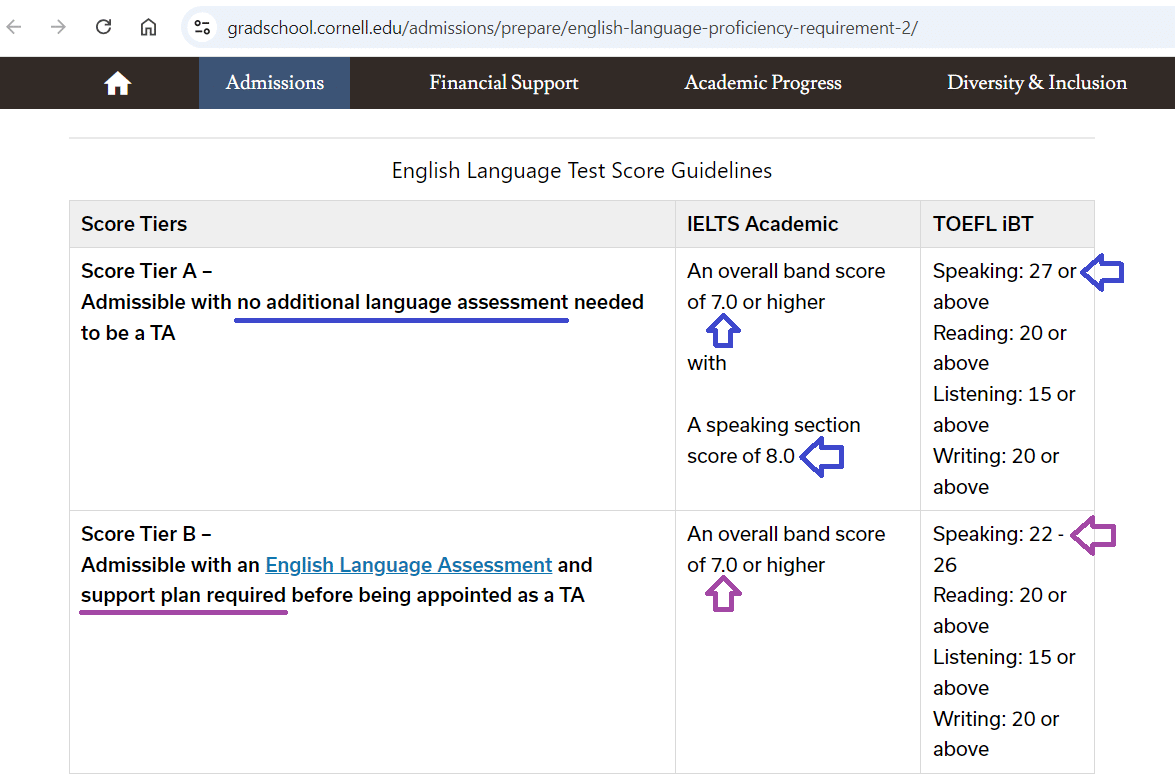
Please note that at some universities, the graduate school requirements may differ from those of individual departments, while at others, they may be the same. For example, the School of Integrative Plant Science at Cornell University explicitly states that they follow the English test requirements set by the graduate school (see the screenshot below):
Example 2: Is the GRE Required?
GRE test results are typically required by North American universities for PhD applicants. However, after the COVID-19 pandemic, some universities no longer require it. Applicants who prefer not to take the GRE must identify universities (or specific departments) that don’t have this requirement. Therefore, when searching within your desired university ranking range, focus on those that don’t require GRE scores. For example, the screenshot below shows that the School of Integrative Plant Science at Cornell University states: Note that consistent with our commitment to holistic evaluation of applications, GRE scores are not required and will not be considered.
Example 3: Should I Contact Supervisors Before Applying for RA-fully funded PhD Positions?
Note that different terms are used for RA funding in various countries. For example, it is called RA funding in the USA and Canada, scholarship in Australia and Finland, and studentship in the UK. Let’s explore different scenarios:
Applying for “research project-based positions” with RA funding?
These types of fully funded PhD positions are typically offered by European universities in countries such as Germany, the Netherlands, Belgium, Switzerland, and others. Unlike program-based applications, each PhD research project often has its own application process. In some cases, you may simply need to email your application package directly to the hiring supervisor, without filling out any online forms. These applications are generally shorter and easier to complete than those required for program-based admissions. While it is not mandatory to contact the hiring supervisor, we highly recommend doing so. Reaching out helps make your name and résumé more memorable and allows you to leave a strong impression through your email.
Applying for “program-based positions” with RA funding?
You can apply for positions with RA funding through departmental application forms for programs in the USA, Canada, Australia, Italy, Poland, and Canada. It is common practice among applicants to find a supervisor in this process to find out if they have available positions in their research group. After contacting supervisors and receiving feedback, you can decide which universities to finally apply to. Typically, students with a strong publication record follow this path for their university application process. This is especially true if they don’t have a high enough English test score for TA funding, as they hope their strong publication track record can secure RA funding.
Program-Based PhD Positions in the USA and Canada
Some universities in the USA and Canada provide specific guidelines about this step. For instance, the Department of Chemical and Materials Engineering at the University of Alberta explicitly states that you do NOT need to secure or find a supervisor before submitting your application (see the screenshot below). Therefore, contacting supervisors can vary depending on university and departmental policies. You may need to:
- Find a supervisor before applying to programs.
- Find a supervisor after applying to programs.
- Not contact supervisors at all.
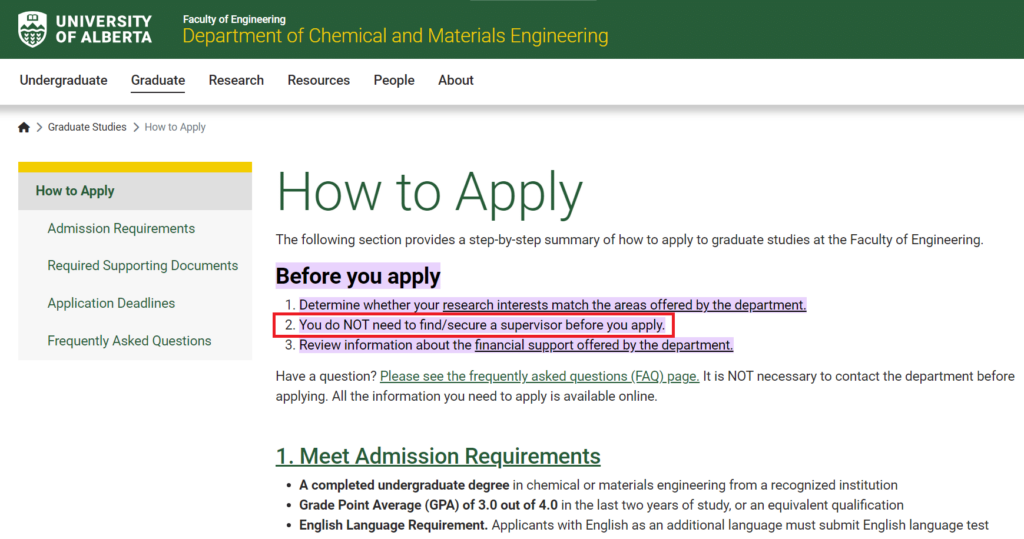
As demonstrated in the screenshot below, a professor at Drexel University advised an applicant that finding a supervisor before formal application submission is unnecessary. While some applicants may not secure RA or TA funding immediately after the admissions committee reviews their application, receiving an admission offer from the applied department allows you to seek TA positions advertised on the department’s website or pursue RA funding by contacting supervisors. Please note that this policy may vary across universities and departments.

Program-Based PhD Positions in Australia and Europe
Please note that in 95% of cases, contacting supervisors is mandatory for applying to PhD programs at Australian universities. Failure to find a PhD supervisor will prevent you from submitting your PhD application. While most PhD positions in Europe are pre-defined research projects posted by universities, PhD programs still exist. Some research centers and institutes in Europe offer fully funded PhD and doctoral programs. For example, the German Cancer Research Center (DKFZ) provides numerous vacancies annually for its PhD program.
Record Your Notes About Universities
As you research and explore universities through their websites, you can conveniently take notes about each university directly on their Applyindex profile. This feature allows you to save important details like program requirements, application deadlines, and specific instructions from departments—all in one place. The notes you create are stored securely and are accessible only to you, ensuring privacy and organization throughout your application process. By taking these notes, you won’t need to: (i) jot them down on paper that could get lost, (ii) squeeze them into small cells in an Excel file, or (iii) revisit each university’s website to find the information again.
By having all your notes in one location, you can easily track and compare universities, helping you make informed decisions. No more scattered information or confusion; your personalized notes will remain intact and available whenever you need them, saving time and effort in the future.
Overview of Universities’ Profiles on Applyindex
As shown in the screenshot below, within each university’s profile, you can view your chance of securing a funded position, the university’s a-index ranking, the ‘Bio’ tab, and the ‘My notes’ tab where you can record any valuable information about the university. Applyindex also provides useful links for each university for your convenience. You can also see the number of supervisors and positions from each university in our database. However, these numbers are independent of our matchmaking algorithms. Once you open the supervisors and positions pages, the numbers will decrease as our matchmaking features are activated.

“My Notes” Tab
This tab is one of the most important components of university profiles on the Applyindex website. For your reference, you can copy and paste the link to view the minimum requirements of the university and department you want to apply to, or to check the application deadlines of the relevant program. You can also copy key information you’ve found into the “My Notes” tab for each university, saving time in the future.
For example, see the screenshot below to take notes about each university and department. Be sure to rely only on official university websites, as external sources may not always provide up-to-date information. Things like application fees, deadlines, or the requirement to contact supervisors may change from semester to semester or year to year. Once you’re done, submit your note.

After submitting your notes, they will be stored and displayed as shown in the following screenshot. The date and time you took the note will be recorded, and you’ll see an “edit” option at the top right if you want to make changes later. The “reply” option at the bottom left allows you to add specific comments or updates to the notes you’ve already taken about a university or department.

Step 4. Prepare a Well-Crafted CV
After gathering information from exploring targeted universities in the range obtained from step 3, preparing a Word or PDF resume file is next. It is an important application document regardless of the degree level you are applying for. You should craft a detailed CV with no more than three pages, while a maximum of two pages is optimal. To prepare your academic CV, you can get ideas from previous successful applicants’ samples, which is time-consuming. Alternatively, you may use platforms like LinkedIn, which provide a general CV format. However, Applyindex offers a more tailored approach with its automated, data-driven resume creator, specifically designed for academic purposes.

Applyindex’s Automated Data-Driven CV Generation
When crafting a standout CV for your university application, Applyindex excels in delivering tailored, top-tier documents that set you apart from the competition. We understand that a strong academic resume is more than just a list of credentials. It’s a powerful narrative showcasing your achievements, skills, and potential. Our data-driven approach ensures that every CV is structured according to university expectations, highlighting your strengths in a compelling and professional format. With Applyindex, you are not just submitting a document; you’re presenting a strategic, well-crafted profile that maximizes your chances of securing admission to your dream institution. Here is why you should craft your CV using our feature:
- Tailored Content: Our system crafts a CV that highlights your academic achievements, research experiences, and skills, aligning perfectly with what admissions committees seek. We are dedicated to helping you make a lasting impression and secure your place in the educational institution of your dreams.
- Time Efficiency: Generate a personalized CV within seconds, allowing you to focus more on other critical aspects of your application.
- Cost-Effective: Eliminate the need for expensive services offered by student agencies or education consultants.
How to Export Your CV
1. Complete Your Profile: Log in and fill out your academic and professional details.
2. Generate Your CV: Navigate to your dashboard and click the ‘Click to get your CV’ button.

3. Download and Customize: Within seconds, download your CV in Word format and make any necessary personal adjustments. After downloading the document, it’s important to fine-tune it to reflect your unique qualifications and experience. Make sure to:
- Remove any sections and headings that are irrelevant to your background.
- Include any additional information that may be necessary.
- Modify the formatting or spacing to ensure the document meets the required length. While two pages are the ideal length for a resume, it can be extended to three pages if you have a significant amount of relevant experience to showcase.
The final personalization of your resume takes less than 15 minutes. Still, it ensures that it accurately represents your qualifications and stands out to prospective universities to win a fully funded PhD position. If you want to prepare your CV independently, samples from applicants who have successfully secured funded positions at the master’s and PhD levels are available in your Applyindex profile.
Step 5. Contact Supervisors For Fully Funded PhD Positions
Now that you have gathered the necessary information from universities and prepared your CV, it is time to contact research supervisors at the universities pinpointed in step 3, if you are applying for RA-funded PhD positions. You contact them to find out if there are any open positions within their research group. The purpose of this step is not to guarantee financial support but to find out if any positions are available. Responses you might expect to receive from a potential supervisor are:
- Thank you for your email. I am looking for a new PhD student in my group, however, you should apply directly to the department. Granting financial support is a decision made by a departmental committee.
- Thank you for your interest, but unfortunately, I do not have any open positions for this semester.
- I think that you have a strong CV. When are you free next week to have an interview?
With luck, supervisors might respond by offering the possibility of a fully funded PhD position. If supervisors who have funded PhD positions in Europe, the USA, or Australia are interested in the applicants’ CVs, they might invite the students for an online PhD interview via Zoom, Google Meet, or Microsoft Teams. Thus, students must prepare for the interviews to convince supervisors they are the best fit for the position.
Candidates can streamline their supervisor outreach using Applyindex’s comprehensive tools. From viewing detailed supervisor profiles to accessing information about active grants and research activities, our platform facilitates efficient connections. Email supervisors directly through Applyindex, track your interactions, and organize important notes within our platform. It eliminates the need to juggle multiple websites and software such as Gmail, Gemini, Excel, etc. This streamlined approach saves you time and helps keep everything organized in one place. On our supervisors page, we connect you with supervisors working on research topics that match your interests or background. You can see a list of relevant supervisors from the selected universities to approach to ask for fully funded PhD positions.

Step 6. Choose Target Universities
A set of target universities is essential before submitting formal applications. Many students waste money on application fees by applying blindly or inappropriately to numerous institutions. We help you identify the right target universities for your application strategy. This decision is based on several factors, including:
- The availability and willingness of your recommenders, and the number of recommendation letters they can provide.
- Your chances of securing full funding.
- The country and type of PhD position you apply for.
- The minimum requirements of the university and department.
- Your budget for application fees.
- Your budget for sending official language test results.
- Responses from potential research supervisors (if you have not skipped Step 5).
The Factors Affecting Your Target Universities
a-index
If you have decided to use Applyindex tools and features, be aware that the most important parameter is your a-index, a quantitative representation of your CV strength. The a-index measures how well your profile aligns with the difficulty level of universities offering fully funded PhD positions. As mentioned in step 2, we strongly recommend focusing on the university ranking range where your minimum chance of securing fully funded PhD positions is at least 60%.
Recommendation Letter
Scenario 1: Suppose you plan to apply to North American universities, which typically require 3 recommendation letters for PhD applications. However, your recommenders have told you they will provide letters of reference only for 3 applications. This means that even if you have the financial resources to apply to multiple universities, you are restricted to only 3 applications because of the recommendation letter limit.
Scenario 2: You want to apply to North American universities, but you only have 2 people who are available to write your recommendation letters. Since most North American institutions require 3 letters, you would not meet their minimum criteria. As a result, you will need to focus your efforts on applying to European universities, which generally require only 2 recommendation letters for PhD applications.

Budget
Depending on how much you can spend on universities’ application fees and language tests results sending fees, you are limited to the number of positions you apply to, especially in the USA and Canada. Imagine a scenario where you have enough recommendation letters but face budget constraints. North American universities often charge high application fees and require official test scores, which can increase costs. Given these financial limitations, (i) if you limit your applications to North American universities, potentially reducing your chances of admission offers, or (ii) you may find it more practical to apply to European universities, as many of them do not charge application fees or require formal test results during fully funded PhD application processes.
Feedback from Contacting Research Supervisors
The feedback and responses you receive from supervisors throughout Step 5 can significantly shape your application strategy and influence which target universities you should ultimately consider. By establishing early contact with potential supervisors, you can gain valuable insights into available fully funded PhD vacancies and whether your research interests align with theirs, which can help you make informed decisions when finalizing your university applications.
Step 7. Find Fully Funded PhD Positions
Remember that this step may overlap with steps 5 and 6, depending on the country or university you are applying for. So, you can work on these steps in parallel. PhD positions are generally available in the following three formats:
Programs: These include PhD programs in countries like the USA, Australia, Canada, Italy and Poland. Typically, applying to these positions involves completing lengthy departmental application forms. Visiting university websites for program deadlines and minimum requirements is recommended for these positions.
Research Projects: Primarily found in European universities, these are PhD vacancies. Unlike programs, each research project often has its application form, or in some cases, you may simply need to email your application package directly to the hiring supervisor. These application forms are shorter and easier to complete compared to program-based applications.
Scholarships or Grants: Explore opportunities like PhD Scholarships in Australia or the Marie Curie PhD Scholarship in Europe. Applications for these typically require submission through individual university websites.
Step 8. Prepare Personal Essay
Now that you’ve selected your target universities, you must prepare your Statement of Purpose (SOP) for their programs or positions. Please note that this document may go by different names depending on the country and university, such as a Statement of Interest (SOI), Personal Statement (PS), Motivation Letter (ML), Letter of Motivation (LOM), Cover Letter (CL), or Application Letter (AL). While these documents may vary slightly in length or the questions they address, their purpose is the same—they serve as a crucial part of your fully funded PhD application process. For simplicity, we will refer to all of them as SOP.
General Guide
SOP or SOI
- Purpose: Typically used for both master’s and PhD applications.
- Content: Focuses on your academic background, research interests, career goals, and why you are interested in the specific program or institution. It should be between 1,000 and 1,200 words, not exceeding two pages.
- Common in: American and Canadian universities, less common in European and Australian institutions.
PS
- Purpose: Widely used for both master’s and PhD applications.
- Content: Offers a broader view of your personal and academic background, life experiences, and how they relate to your chosen field or program in no more than one page.
- Common in: Commonly required in American, Canadian, and Australian universities, less common in European institutions.
ML or LOM
- Purpose: Typically asked by European universities for master’s, PhD, and postdoc applications.
- Content: Covers your motivation for pursuing the program, relevant qualifications, and how you fit into the program’s objectives in no more than one page.
- Common in: European universities, less common in American, Canadian, and Australian institutions.
CL or AL
- Purpose: Used more commonly for job applications (like postdoc positions) but can sometimes be requested for master’s and PhD admissions.
- Content: Typically addresses your qualifications, interest in the program, and why you’re a suitable candidate in no more than one page.
- Common in: Less common for graduate admissions, more often seen in job applications.
Specific Guide
Some universities have specific guidelines regarding the content and length of supporting documents. For instance, a few universities in the US and Canada might require an 800-word SOP and a 400-word PS, whereas European institutions often ask for a one-page LOM and a one-page CL. It is essential to closely follow the specific requirements of each university to ensure your application meets their expectations. For example, as shown in the screenshot below, the School of Integrative Plant Science at Cornell University requests both an SOP and a PS, each with detailed guidelines on structure and content. Paying attention to these precise instructions demonstrates your attention to detail and increases your chances of a successful application.
If you’d like to prepare your SOP, SOI, LOM, or CL on your own, many samples from applicants who have successfully secured funded positions at the master’s and PhD levels are available in your Applyindex profile. These examples offer valuable guidance on how to effectively structure your document to stand out to get fully funded PhD vacancies. Each sample highlights key sections, ensuring your SOP, SOI, LOM, or CL is impactful.
Step 9. Secure Recommendation Letters
Now that you are one step closer to uploading your documents and submitting the application form, it is time to ask for your recommendation letters from your previous or current research supervisor(s), course lecturer(s), or employer(s). Note that a recommendation letter is also called a letter of recommendation, a reference letter, or a supporting letter. A well-crafted recommendation letter should be concise, usually 1-2 pages, and tailored to the specific PhD program, emphasizing the applicant’s strengths in a compelling and structured manner.
Step 10. Apply for Fully Funded PhD Positions
According to the supervisors’ final feedback, the number of required recommendation letters, and their budget, the students should prepare a list of targeted universities to which they will officially apply. Students must write a strong statement of purpose (SOP), or motivation letter, to convince the admission committee of the department/university to which they are applying. After all the documents needed for the official application are ready, students go through the process and submit their applications. If required, students have to pay application fees before the application submission.

Last Words on Fully Funded PhD Positions
Once you receive an admission offer letter for a fully funded PhD position from a university, you should begin applying for a student visa. In summary, fully funded PhD positions are highly sought-after worldwide, with students often searching for opportunities in Europe, the USA, Canada, and Australia. Navigating the complex process to apply for fully funded PhD positions can be challenging. Applyindex provides a 10-step roadmap to guide students from the initial stages to securing a fully funded PhD. While specifics may vary based on individual backgrounds and destinations, pursuing a fully funded PhD offers a rewarding academic and research journey.
Frequently Asked Questions (FAQs)
What is the a-index, and how does it help PhD applicants?
The a-index is an AI-generated score between 50 and 100 that reflects the strength of your academic CV. A higher a-index indicates a stronger application profile and a better chance of securing a fully funded PhD position. It helps applicants target universities within their realistic funding range.
Do I always need to contact supervisors before applying for PhD positions?
Not always. In the USA and Canada, it depends on whether you’re applying for RA- or TA-based fully funded PhD positions. In Australia, contacting a supervisor is usually mandatory. In Europe, project-based, fully funded PhD positions may or may not require supervisor contact, but doing so is often helpful.
How can Applyindex streamline the PhD application process?
Applyindex provides tools to create academic CVs, match applicants with supervisors, estimate funding chances, evaluate CV strength (a-index), and monitor university information. It saves applicants a great deal of time and effort by combining all the steps onto a single platform, eliminating the need to visit several websites.
What factors limit the number of PhD applications I can submit?
Your budget for application and test fees, the quantity of recommendation letters your referees are willing to provide, and the availability of recommenders are important limiting factors. These limitations may make it more difficult for you to apply widely, particularly to universities in North America.
What types of fully funded PhD positions can I apply for?
You can apply for (1) program-based PhDs (common in the USA, Australia, Canada) and (2) project-based PhDs (mainly in Europe).


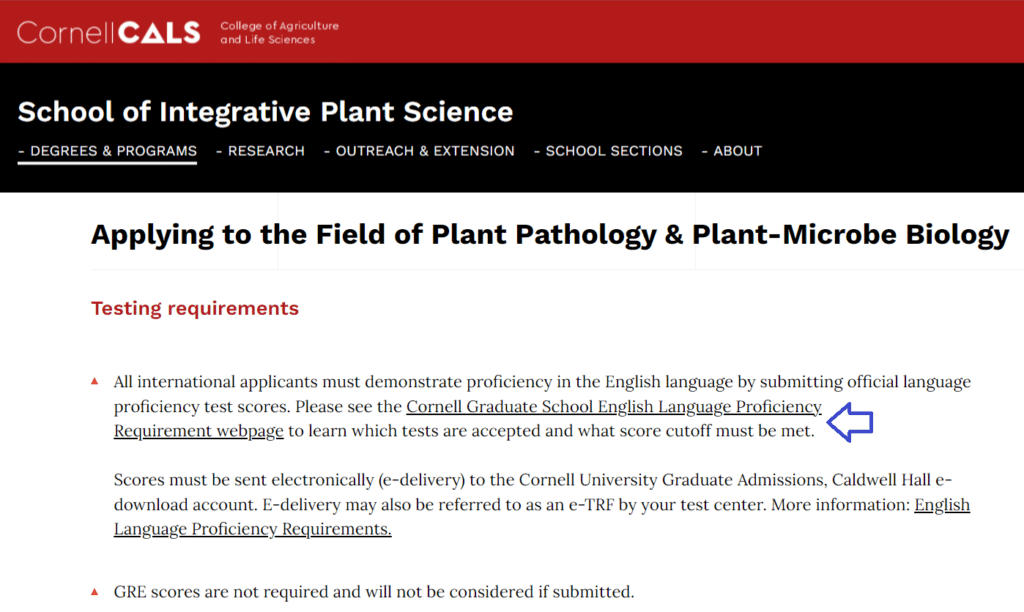
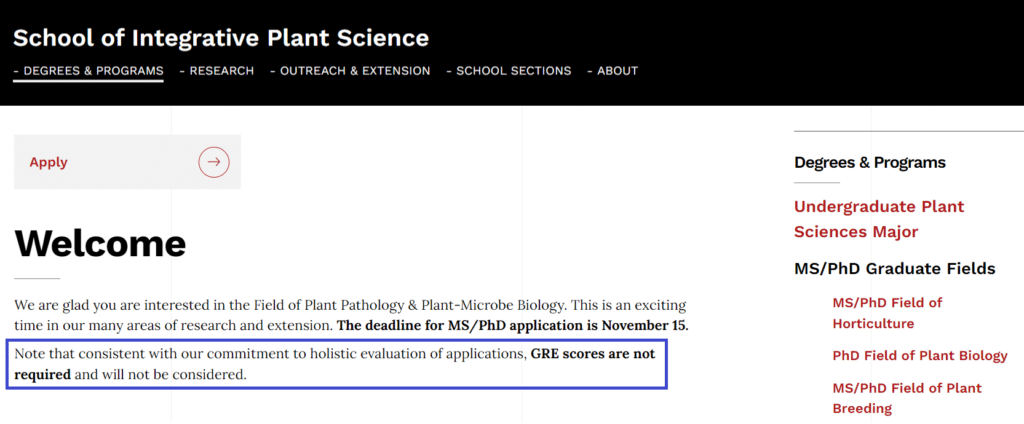




0 Comment